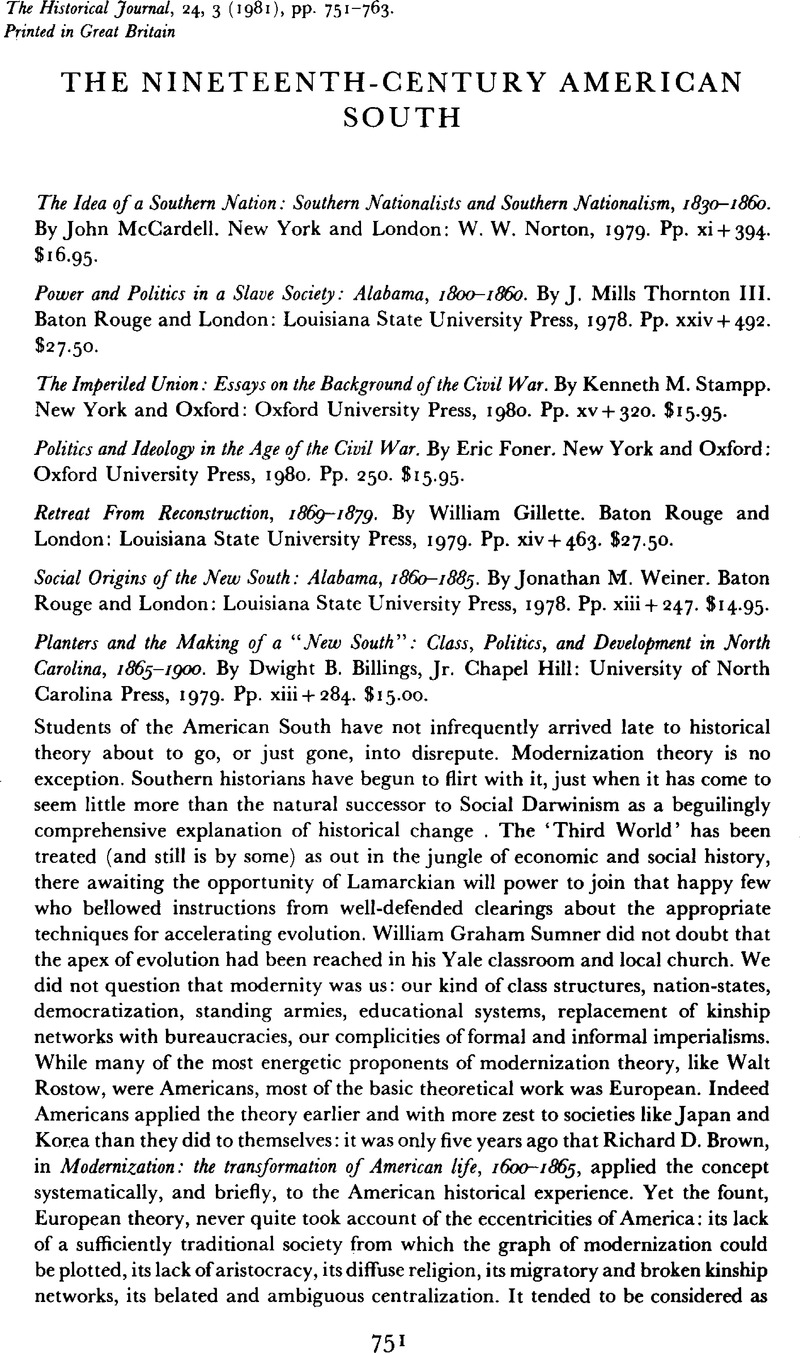No CrossRef data available.
Published online by Cambridge University Press: 11 February 2009

1 For example, Seymour, Martin Lipset, The first new nation: the United States in historical and comparative perspective (New York, 1963).Google Scholar
2 Potter, David M., ‘Civil War’, in The comparative approach to American history, ed. C., Vann Woodward (New York, 1968), 135.Google Scholar
3 McCardell, pp. 8, 3.
4 John, Higham, ‘Introduction’, in New directions in American intellectual history, eds. John, Higham and Conkin, Paul K. (Baltimore and London, 1979), pp. xvi–xvii.Google Scholar
5 That useful if occasionally bizarre compendium, The encyclopedia of Southern history, eds. Roller, David C. and Twyman, Robert W. (Baton Rouge, 1979) is exceptionally weak on the region's intellectual history; it omits, for example, important thinkers like James Henley Thornwell, Frederick A. Porcher, William Elliott, Louisa McCord, George Frederick Holmes, William Henry Trescot, Basil Gildersleeve, John Bachman, and Robert Henry. Moreover, many figures, like Hugh Swinton Legaré, who are as notable for their intellectual as their political careers, are portrayed just as politicians.Google Scholar
6 Joyce, Appleby, ‘Modernization theory and the formation of modern social theories in England and America’, Comparative Studies in Society and History, xx (April 1978), 261.Google Scholar
7 Thornton, p. xvii.
8 Cooper, William J. JrThe South and the politics of slavery, 1828–1856 (Baton Rouge, 1978) is prey to a circular logic, however; it assumes that Southern politics are centrally about slavery, proceeds to document what politicians said on the matter of slavery (with, it must be said, great skill and thoroughness) and then triumphantly concludes that this demonstrates the centrality of slavery.Google Scholar
9 Green, Fletcher M., Constitutional development in the south Atlantic states, 1776–1860 (Chapel Hill, 1930);Google ScholarOwsley, Frank L., Plain folk of the South (Baton Rouge, 1950);Google ScholarGenovese, Eugene D., The world the slaveholders made (New York, 1969);Google ScholarOlsen, Otto H., ‘Historians and the extent of slave ownership in the Southern United States’, Civil War History, XVII (June 1972), 101–16;CrossRefGoogle ScholarFredrickson, George M., The Black image in the White mind: the debate on Afro-American character and destiny, 1817–1914 (New York, 1971).Google Scholar
10 Thornton, p. xix.
11 David, Donald, ‘An excess of democracy: the American Civil War and the social process’, in Lincoln reconsidered: Essays on Ike Civil War era (New York, 1956), pp. 209–35; this was Donald's inaugural address as Harmsworth Professor at Oxford, which may help to explain its tory tone and willingness to use Henry James as an expositer of American social history.Google Scholar
12 Brown, Richard D., Modernization: the transformation of American life, 1600–1865 (New York, 1976), p. 183;Google ScholarRaimondo, Luraghi, ‘The Civil War and the modernization of American Society: social structure and industrial revolution in the Old South before and during the war’, Civil War History, xviii (September 1972), 230–50;Google ScholarThomas, Emory M., The Confederate nation, 1861–1865 (New York, 1979).Google Scholar
13 Stampp, p. 107.
14 ibid.. p. 235.
15 Foner, p. 32.
16 Gavin, Wright, The political economy of the cotton South: household, markets, and wealth in the nineteenth century (New York, 1978): but it is important to remember, here as elsewhere, that Wright's analysis applies only to those parts of the South identical with the cotton economy, which are not interchangeable with the whole region.Google Scholar
17 Immanuel, Wallerstein, ‘American slavery and the capitalist world-economy’, American Journal of Sociology, LXXXI (March 1976), 1199–1213;Google Scholar‘The memoirs of Frederick Adolphus Porcher’, ed. Stoney, S. G., South Carolina Historical and Genealogical Magazine, XLVII (April 1946), 95.Google Scholar
18 Gillette, p. 450.
19 The works and life of Walter Bagehot, ed. MrsRussell, Barrington, 11, 323,Google Scholar quoted in Burn, W. L., The age of equipoise: a study of the mid-Victorian generation (London, 1964), p. 55.Google Scholar
20 Weiner, p. 3
21 ibid. p. 219.
22 Thornton, p. 444.
23 Billings, p. 34.
24 Cf. Weiner, , ‘Class structure and economic development in the American South, 1865–1955’, American Historical Review, LXXXIV (October 1979), 970–92, and the indignant comment by Robert Higgs (pp. 993–7).CrossRefGoogle Scholar